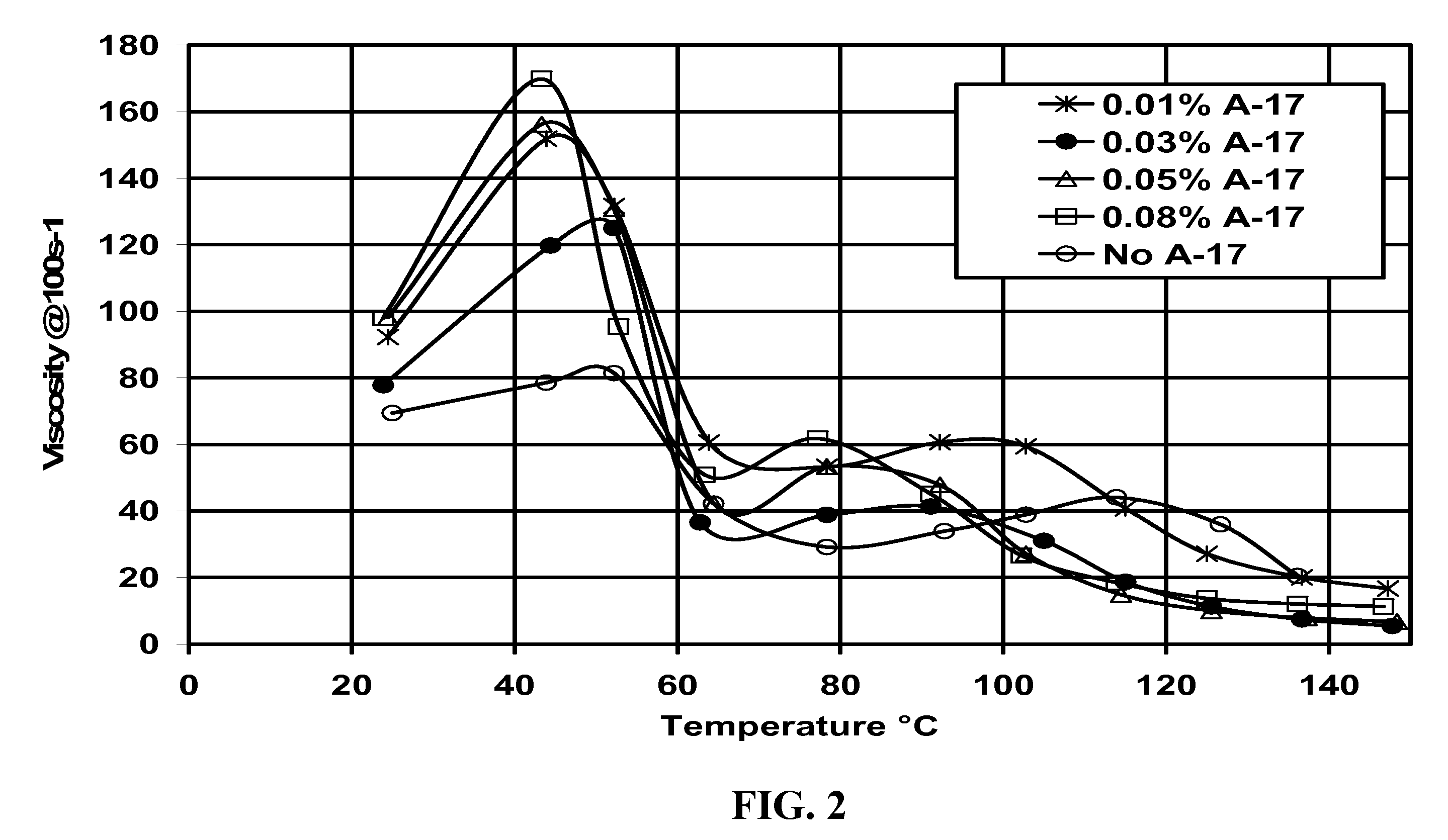Rheology Modifiers
a technology of viscoelastic surfactant and modifier, which is applied in the direction of liquid soap, sealing/packing, and well accessories, etc., can solve the problems of reduced stability, increased shear sensitivity, and reduced viscosity, and achieves the effect of increasing the rate of shear rehealing
- Summary
- Abstract
- Description
- Claims
- Application Information
AI Technical Summary
Benefits of technology
Problems solved by technology
Method used
Image
Examples
example 3
[0054] Shown in FIG. 4 is the viscosity as a function of temperature of fluids containing 6 wt % VES, from about 0.06 to about 0.72 wt % D-17, and 2 wt % KCl, with and without 0.1 wt % PPG. It can be seen that this 4000 molecular weight polypropylene glycol had some effect on the viscosity. Furthermore, in these experiments, the final shear recovery time of the fluid without the PPG was about 15 seconds while the shear recovery of the fluid with the PPG was almost instantaneous. The maximum amount of additive used in the experiments of example 3 (0.1 wt % of the fluid) was about 4.2% of the weight of surfactant (there was 6 wt % in the fluid of a concentrate containing about 40% active surfactant).
example 4
[0055]FIG. 5 shows the viscosity as a function of temperature of fluids containing 6 wt % VES, 0.072 wt % D-17, 2 wt % KCl, and varying amounts of PPG. Increasing amounts of PPG raised the viscosity at temperatures below about 60° C. and decreased the viscosity slightly at temperatures above about 90° C. Note that the viscosities were quite insensitive to the PPG concentration. The maximum amount of additive used in the experiments of example 4 (0.125 wt % of the fluid) was about 5.2% of the weight of surfactant (there was 6 wt % in the fluid of a concentrate containing about 40% active surfactant).
example 5
[0056] In other experiments, for which the data are not shown, a fluid was made containing 6 wt % VES, 0.072 wt % D-17, and 2 wt % KCl. This fluid was mixed in varying amounts (ranging from 10% VES fluid to 50% VES fluid) with a linear gel fluid containing 4.8 kg / L guar and the viscosity was measured from about 25° C. to about 145° C. The viscosities of the mixed fluids was about what would have been expected from the mixing and diluting effects alone; there was no indication that the guar had broken the VES fluid. This is important because the two fluids could come in contact with one another in use, and these experiments show that they are compatible with one another.
PUM
| Property | Measurement | Unit |
|---|---|---|
| shear recovery time | aaaaa | aaaaa |
| time | aaaaa | aaaaa |
| weight percent | aaaaa | aaaaa |
Abstract
Description
Claims
Application Information
 Login to View More
Login to View More - R&D
- Intellectual Property
- Life Sciences
- Materials
- Tech Scout
- Unparalleled Data Quality
- Higher Quality Content
- 60% Fewer Hallucinations
Browse by: Latest US Patents, China's latest patents, Technical Efficacy Thesaurus, Application Domain, Technology Topic, Popular Technical Reports.
© 2025 PatSnap. All rights reserved.Legal|Privacy policy|Modern Slavery Act Transparency Statement|Sitemap|About US| Contact US: help@patsnap.com



